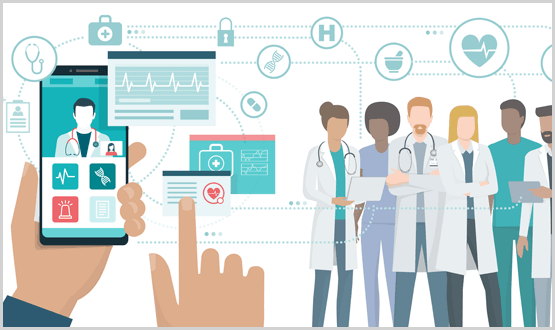Site visit: North West Shared Infrastructure Service
- 29 September 2016

In the NHS, even the simplest act of sharing can be complicated. Take the Preston Business Centre, which houses some Lancashire rehabilitation services, the North West Shared Infrastructure Service, and, on the top floor, the local NHS England team.
While NW SIS and rehabilitation services staff can log-on to each other’s secure networks – and, indeed hundreds of others scattered throughout the North West – NHS England staff live on a network island.
The staff can log-in to NHS England network at the commissioning board’s Leeds HQ, but not their NHS colleague’s network downstairs. Andrew Thompson, head of the NW SIS, shakes his head while revealing this anomaly. “They’ve even got their own telephone system.”
It takes two
Since 2002, NW SIS and its predecessors have been slowly trying to eliminate the silos that run deep into the foundations of NHS’s IT Infrastructure.
On its inception, the service covered just two NHS organisations, Lancashire Care NHS Foundation Trust and Chorley and South Ribble Primary Care Group.
The two organisations had decided to pool their money and pay for a shared infrastructure. Specifically, they wanted to share a Microsoft Active Directory and a set of processes to authenticate staff members and computers.
The idea was that if a Chorley and South Ribble clinician turned up at a Lancashire Care site, the IT infrastructure would already recognise them and vice-versa.
A small thing, but Thompson says this foundation has created a base for everything that has been built since. “It’s not sexy. It’s the sort of stuff people don’t want to know exists; but if it goes down people run for hilltops.”
In the years since, the two founding organisations have evolved, or been replaced, but the directory has continued to grow, expanding to eight NHS organisations and spilling out of Lancashire. Dozens of smaller organisations, such as GP surgeries, are connected through the five clinical commissioning groups that are now involved.
The most recent arrival is the North West Ambulance Service NHS Trust, and NHS Cheshire CCG is awaiting approval to join. Thompson says that once the latest pipeline comes through, 200,000 NHS staff will be on the directory.
Directions through the forest
With so many staff on a single directory, whoever controls the access potentially has a huge amount of power.
Lee Ballinger, the technical director of BDS Solutions, which set up the directory more than a decade ago, and which still provides IT help desk support, says convincing trusts to replace their own Active Directory with one that is managed remotely is a big ask.
However, the company created a forest root domain structure that allows each organisation to set-up and control its own local directory, which has overcome this reluctance, at least to some extent. Each local directory sits on top of single instance master directory that links them all together.
The master directory layer is independent of the physical IT infrastructures that are owned and managed by each of the member organisations, and their networks, of which there are six or seven, with different suppliers.
Ballinger says this pared-down, multi-tenanted model is what has allowed NW SIS to grow. In essence, it’s been able to add new directories without have to re-jig the overarching structure or any of the physical kit. “Each organisation has its own domain, but the forest domain was the key decision that allows this system to scale.”
Your office, anywhere
Still, it’s not the architecture that gets organisations on board, so much as what they can do with it. Bridgewater Community Healthcare NHS Foundation Trust signed-up to NW SIS in 2013.
Its head of IT, David Smith, says the use case came down to being able to walk into another trust’s building and turn on a computer.
Smith and any of the 100,000 NHS staff NW SIS covers at the moment can do just that. They can sign-in to the network at any NHS site, using any certified device, and access the services they would at their home trust.
Many Bridgewater Community Healthcare clinicians are now equipped with hybrid laptop. If they are out visiting patients, they can head for the nearest NHS organisation car park, hook-up to the wi-fi and log-in as if they were in their own office.
“When you need clinicians to work out of multiple acute sites and have a single sign-on to the systems they need, the use-case is very clear,” Smith says. “What [the NW SIS directory model] means is you are known whatever site you go to.”
Bells and whistles
NW SIS isn’t a supplier. It finds suppliers, agrees on a contract for shared infrastructure services, and offers them to its member organisations. “We are a contract manager. If it can be provided at scale, we get involved,” Thompson explains.
On top of the active directory set-up, NW SIS has stacked more and more services for organisations to pick from. These have included voice services, telehealth, Skype video conferencing, an information governance system, and secure mobile and messaging.
It has also arranged a secure wi-fi contract, through The Networking People, for both staff and patients, and is looking at turning ambulances into mobile wi-fi hot spots.
The directory set-up also forms the identity and authorisation foundation for the Lancashire Patient Record Exchange System, or LPRES, a project to a create a health and social care information exchange across Lancashire.
The future
At a national level there are plenty of big changes coming to IT health infrastructure in the next few years. These include a new NHSmail2 and HSCN connections to replace the N3 network.
NW SIS is likely to be heavily involved in delivering these new services in the North West, but it is also looking at new options for improving economies of scale and interoperability. These include investigating cloud-based services, business intelligence, and more patient facing services.
Thompson also wants NW SIS to expand even further and bring on board those NHS organisations, and councils, that are still running their own directories and infrastructure services.
This will be easier in some areas than others. Both Merseyside and Manchester have developed their own, albeit different, shared services and are unlikely to discard these systems to join NW SIS.
“There have been conversations about extending out further, but changing hearts and minds takes time,” he says. The door is also open if the commissioning board comes knocking. “I’d be quite happy to show NHS England all of this.”



